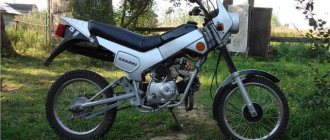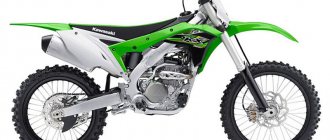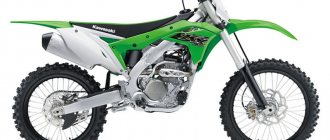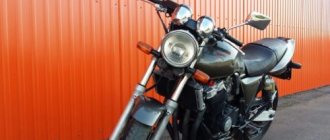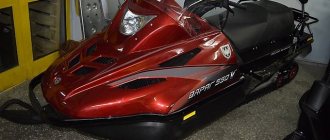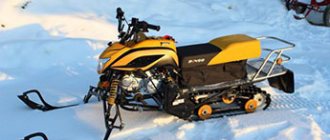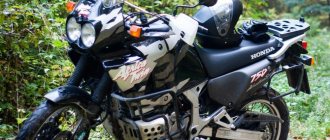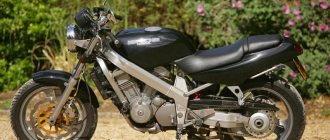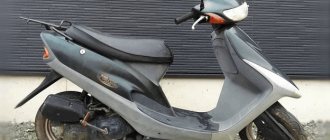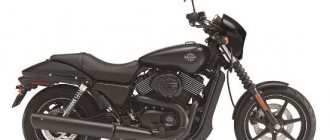Plant named after V. Degtyarev, better known to us as ZiD, was founded during the First World War. It was then that the first buildings of the Kovrov Machine Gun Plant began to be erected in Kirov. Many years later, in 1946, he began producing motorcycles. Many probably remember the legendary K-125, Kovrovets and, of course, Voskhod. And the very first small-capacity motorcycle from the Kovrov plant came off the line only in the nineties of the last century. It was a ZiD-50 Pilot model.
Repair and tuning
Even before the plant named after. Degtyarev was bought by the Chinese, this mokik had enough tuning, which enterprising citizens ordered from China. And everything necessary for repairs can be found in Russia, and it is inexpensive.
Repair
The moped has several weak points. Firstly, the front fork often starts to leak. The problem is eliminated by replacing the oil seals and anthers, but when driving over rough terrain, sooner or later it will appear again. Secondly, the original K39 carburetor is not of high quality, and problems often arise with it. Many owners change it to a Chinese equivalent.
Spare parts
Despite the fact that the ZiD 50 moped was discontinued a long time ago, there are practically no problems with finding spare parts. Almost everything you need is easily found in motorcycle shops and markets. The price tag for the parts will make any motorcyclist cry with envy - they are sold almost by weight.
Tuning
Rural bikers have gotten used to adding various optional improvements to the mokick, such as new handlebars or windshields, but the main thing is that it is possible to change the piston, increasing the volume. On Aliexpress, and even in Russia, you can find 70 cc CPGs that fit perfectly on the original engine. As a result, the moped's agility noticeably increases.
Technical characteristics of ZiD Pilot 50
ZiD Pilot is inferior to all modern analogues, but when it first went on sale, it was head and shoulders above the usual “Karpaty” and “Riga”. But its technical characteristics were good for its time, which was the reason for the high popularity of the model.
Engine
A conventional 2-stroke air-cooled engine with 2 valves and one spark plug, capable of accelerating a ZiD Pilot moped to 60 kilometers per hour. The manufacturer declared a maximum speed of 50 km/h, but this was done so that, according to the documents, the bike meets the requirements for mopeds. Engine power is 2.7 horsepower, torque is about 2 Nm.
Transmission
The archaic 3-speed gearbox works very smoothly. Unlike Chinese pit bikes, the gears are changed like on a motorcycle - the first one is down, the rest are up. The third can be safely engaged already at 30 km/h.
Chassis and brakes
It's hard to come up with something simpler. ZiD Pilot 50 has a steel frame, mechanical drum brakes on both wheels and a standard suspension with a telescopic fork at the front and a monoshock absorber at the rear. The suspensions do not have high energy intensity, but since the moped is designed for one person, they are enough.
Electronics
There is practically no electronic filling in the Pilot. It doesn't even have a battery! So the light optics are powered directly from the generator. There is no electric starter either - please be content with the kickstarter. Everything is simple, even primitive, and therefore very reliable.
Weight and dimensions
The dry weight of the moped is only 87 kg, and the loaded weight is about 100 kg. Any motorcyclist, even an inexperienced one, can handle the ZiD 50 Pilot. And thanks to its modest dimensions, the mokik can easily make its way between cars in traffic jams if its owner gets carried into the city. But it is better to avoid traveling on busy roads, since the bike clearly does not have enough power for them.
Controllability
Thanks to its modest weight and compact dimensions, the ZiD 50 01 moped is not just easy to control, but very easy. You just need to get used to the ease with which it tilts and the steering wheel, which is not very convenient for long-armed drivers.
Fuel consumption
A 2t engine, by definition, is not economical, and the mokik from the factory named after. Degtyareva, without hesitation, consumes up to 2.5 liters of gasoline per 100 km. The ZiD Lifan version with a 4t engine has lower fuel consumption, and the Chinese replaced the archaic K 39 carburetor with their own, more modern one.
ZID – 36
It was a tiny motor scooter, which was also foldable. This made it possible to transport it in the trunk of a car and store it on the balcony of a high-rise building. The model was equipped with a powerful engine and reached speeds of up to 35 kilometers per hour. The ZID-36 existed from 1997 to 2007, but turned out to be economically unprofitable and was discontinued.
Welcome to the site dedicated to mathematics and modeling!
Propping a stool with paper marketing textbooks, you can screw in a light bulb on the ceiling, but this, of course, cannot be done with electronic marketing textbooks, but you can download them for free and very quickly. With a simple textbook you can press down a crumpled sheet of paper and it will become smooth. The electronic textbook can be shared with friends. Design textbooks are usually not printed because their authors prefer to distribute online copies. Much historical knowledge has already been lost, but now, with the ubiquitous presence of the Internet, not a single textbook will be lost anymore. If previously schoolchildren earned themselves a curvature of the spine by carrying heavy backpacks filled to capacity with textbooks, now they wander to school lightly, tripping over objects due to poor vision, spoiled by a computer monitor.
Poor students used to fly out of universities in droves simply because they did not have electronic textbooks and could not get a paper textbook due to the long queue. Or because they didn’t have time or forgot to turn in the textbook they borrowed from the library on time. Now each student can have a copy of their own textbook. Electronic textbooks have made a real revolution in the education system. They save many people time and money. Ease of use provides many advantages over paper versions of textbooks.
Millions of people around the world prefer electronic textbooks to regular ones. Speed of access, ease of finding, ease of storage, the possibility of free replication - this is not a complete list of the advantages of online textbooks. And their choice is obvious. Little by little we will eradicate paper textbooks, thereby preserving our nature and increasing our wealth.
Mathematics and Modeling
Advantages and disadvantages
When considering them, we must not forget that we are talking about a simple entry-level bike, produced a decade and a half ago, and designed using the technologies of the last century. For its time, this model was quite good.
Advantages
- Light weight. Everyone can cope with mokik.
- Simple design. Disassemble, repair, and put the ZiD moped back together - no problem, even if this is your first bike.
- Reliable engine. The transmission is also not particularly fragile.
- Nice pendants. They confidently handle roads without asphalt.
Flaws
- No passenger footrests. The bike is designed strictly for one person.
- Weak brakes.
- The volume of the ZiD 50 gas tank is only 6 liters.
Moped Mokik ZID 50 01 Pilot
Moped Mokik ZID 50 01 Pilot
Moped
mokik ZiD 50 01
Pilot
Mokik is a moped that is made according to the design of the most ordinary motorcycle - without a bicycle drive and with a gearbox.
There are rumors that they will start assembling the most popular domestic “fifty dollars” with a Chinese 4-stroke engine on the ZiD. The rumors materialized.
The moped is a sports road model (mokika) produced by the plant named after. V. A. Degtyareva.
It is intended for tourist travel, business trips and walking on roads with a variety of surfaces.
The plant equipped the “Pilot” moped with a new 4T engine and released a more advanced version of the moped, called “Active”.
Apart from the new four-stroke, there are not many changes in the design, but they will pleasantly surprise you.
The clutch lever has disappeared - here it is centrifugal, semi-automatic. A round window appeared near the speedometer, the green letter N glows in it, and next to it you can see unlit numbers from one to four.
Instructions:
That's right: if you turn on a particular gear, the corresponding number will light up, they are located in a circle. And this is not at all an accident, since this gearbox also shifts “in a circle”, neutral is after the fourth, then the first, etc. Or vice versa, when you change gears in the reverse order.
Shifting from 1st to 4th occurs when you push down the lever under your left foot.
The Pilot was equipped with a Chinese-made version of a 50 cc engine.
A little more pleasant news: a button has appeared on the right switch box - this indicates the presence of an electric starter.
It is impossible to “force” an engine that has not been run in; it will only really run after ten hours of driving. It doesn’t work – really. At engine speeds above average it becomes sluggish. You need to drive at least five kilometers. Already at the third kilometer the mokik transforms, and goes well by the sixth kilometer. The engine pulls well at low end.
Details:
You can burn out the pads very quickly if you rely only on automatic transmission and don’t rush to switch gears to lower ones in a timely manner. You should “open” the gas only when you turn on the idle speed, when you move off, if you want to save the transmission. Detail: vibrations that tire the driver - not at all.
For beginners, a very convenient “simulator” is the one with the Chinese “Pilot” motor.
It’s not bad that the engine is sluggish until the end of the run-in, the engine will gain strength as it runs in, and the driver will have invaluable experience.
Mokic basically remained as it was. The capabilities of the “fifty kopeck” correspond to the rear brake. And the “tenacious” front brake can actually turn out to be very dangerous, because the tires only slightly “hold” the road.
New opportunities will be opened by installing the “Chinese” on “Pilots” for successful sales of vehicles.
The first swallow
The ZiD-50 “Pilot”, which appeared on domestic roads in 1995, became the first moped of this plant. And four years later, another batch with a raised wing in front was released in Kirov. It was called "Active". And although it was, like the Pilot, two-stroke, there was a significant difference: it differed from its ancestor in the presence of an original plastic body kit in the style of cruisers. In 2004, this version was slightly improved by creating the ZiD-50–01, which was equipped with a four-stroke Chinese Lifan engine with a power of 2.72 horsepower.
It is noteworthy that this model used a semi-automatic clutch, as a result of which its handle disappeared. Like the ZiD-50 “Pilot” moped, it was also intended for tourist and business trips. The vehicle was also suitable for walking on a variety of surfaces.
ZID 50-05 or ZID Lifan 50
Later, the ZID 50-05 model was produced at the Degtyarov Plant. It was a licensed copy of the famous Lifan 50 scooter. The Russian model was similar to its Chinese counterpart. Its main advantages include:
- powerful four-stroke Lifan 1P39FMA engine;
- air cooling of the engine;
- weight not exceeding 82 kilograms;
- strong plastic casing that is not subject to mechanical stress and corrosion;
- large bright headlight;
- presence of a passenger seat;
- the presence of spacious trunks for storing things and equipment located under the driver’s seat and dashboard;
- presence of a glove compartment for documents and small items, locked with a key.
The features of the ZID 50-05, like the Chinese scooter Lifan 50, include:
- a soft saddle that allows you not to get tired from a long journey;
- alloy wheels for wheels;
- easy to read dashboard;
- comfortable seat for the passenger;
- the presence of handles that the passenger can hold on to.
ZID 50-05 and the Lifan 50 scooter were famous for their:
- small size;
- ease of control;
- increased maneuverability;
- high level of security.
The Lifan 50 scooter model and its Russian copy are suitable for beginner motorcyclists. Driving them does not require special knowledge, skills or training.
The Lifan 50 scooter is a high-quality and fashionable model of scooters that has reached a high level of popularity in the world. ZID 50-05 was also in demand because it was of high quality and quite cheap.
ZID 50 "Arkan"
The first model of a domestic scooter, released in 2000. The advantages of the model include:
- chassis from a moped ZID – 50 “Pilot”;
- powerful battery;
- indicators of fuel level, low oil quantity;
- separate lubrication system
This model differed from foreign ones in the presence of a three-speed gearbox. It was mechanical, not CVT. However, it was precisely because of this detail that the scooter was not in demand, although it was sold very inexpensively.
Later, scooter models with an engine capacity of 50 liters were released. These included “Nika”, ZID-50 “Arkan” with a CVT, ZID KM.
Domestic mopeds
The world of domestic motor vehicles today is known mainly only to Russian users. Our motorcycle manufacturers have not gone as far in creating quality products as our competitors from Japan. It is clear that domestic motorcycle production is noticeably behind its foreign “brothers.” But, nevertheless, among domestic mopeds there are their leaders and we can highlight their production advantages.
For example, the Verkhovyna moped is distinguished by its design and small size of the gas tank, although many are not satisfied with the “window” between the saddle, tank, white side drawers and two diagonal frame pipes. Such a domestic moped as “Stella/Babette” is distinguished by its comfort. If we talk about the "Delta", then it can be described as a moped
with good stability and controllability. Plus, it has always been distinguished by its design, thanks to which many called the Delta a mini-motorcycle. It is also worth noting the release of Riga mopeds, where a good ride and comfortable fit distinguishes the Riga-7. But there are also those who prefer a model as small in size as the Riga-22. It turns out that domestic manufacturers also have something to brag about.
Below are the technical characteristics of some ZID mopeds and other models. The Namopede.ru portal invites you to take a closer look at some of the domestically produced models.
Let's take a domestic moped called “Ptah”. As if justifying its slightly frivolous name, it looks like an ordinary bicycle, rather even like a children’s one. And its driving performance leaves much to be desired. The Arkan mini-scooter looks much better and more profitable: despite the fact that the design and assembly are lame, this device looks like a European model of a middle-class scooter. It has a three-speed gearbox and a two-stroke engine.
A few more words about Russian models: the domestic moped “Pilot” - this machine has received quite a lot of good reviews. Although some users of the domestic moped " Pilot
“complain about the excessive “stuffing” of mechanisms that reduce the speed capabilities of the “Pilot”. It is believed that the Pilot has the best braking system among Russian models. Therefore, we invite you to familiarize yourself with its technical characteristics and appearance. Sales and repairs of domestic mopeds are carried out in many service centers in Russia and Ukraine. The Namopede.ru portal offers you a list of stores where motorcycles are sold.
But do not forget that when purchasing a moped or scooter, you have every right to ask any questions regarding the product you are purchasing. How carefully you approach the choice of means of transportation will determine the long-term life of your moped, and your own
Another point that is worth paying attention to is the legal side of the matter. Previously, in many countries, in order to freely drive on city roads, you did not need to obtain a driver’s license or register your vehicle
Today the situation has changed dramatically: many countries around the world have already passed a law that obliges all owners of vehicles such as mopeds and scooters to have both a driver’s license and state registration. In Russia, Chapter 24 of the Road Traffic Rules states: “by decision of the executive authorities of the constituent entities of the Russian Federation, a procedure may be established that requires moped drivers to have a document confirming their knowledge of the Rules, and for these vehicles to have a special registration plate.” Such restrictions are introduced in order to improve the culture of communication on the road, both on the part of drivers and on the part of pedestrians.
So, the motorcycle business in Russia is not yet as developed as in Japan and China. But the legal settlement is in step with the laws of Europe and Asia.
Specifications
The technical characteristics of the device include several indicators:
- Size and comfort.
The length of the mokika with a body is 2350 cm, width is 1050 cm, height is 780 cm, the body does not create problems while driving. The driver's seat is soft and comfortable, the steering wheel grips are at a comfortable height. One more person can easily fit in the seat behind the driver. A small engine volume allows you to operate the device without special rights - Engine and gearbox. Engine power 2.72 horsepower, cylinder volume 50 cm3. With these parameters, on a flat road with an average load, the speed of the mokik reaches 50 km/h. At the same time, the engine is quite economical, consuming only 2.2 liters per 100 km. The cooling system is air, using oncoming air flows when driving. The gearbox is manual, 3-speed. There is a reverse speed.
- Brakes. Drum-type, capable of abruptly stopping even a loaded trike.
- Suspension. The suspension has a set of shock absorbers, which makes driving even off-road soft and comfortable.
- Wheels. Light, inflatable, of the same diameter. This allows you to buy a set of tires and tubes at once, without remembering the difference in size between the front and rear wheels.
- Additional equipment. Additional equipment includes rear-view mirrors, turn signals and a powerful headlight, and there is also a signal.
Model range overview
The lineup consists of the following models:
Zid 50. The Mokik ZiD 50 carburetor creates a power of 2 horsepower. However, there are modifications that depend specifically on the number of revolutions and, accordingly, power.
The moped model range has several options
- ZiD 50-01 with carburetor Mokik ZiD 50 01.
- ZiD 50-02 with Mokik ZiD 50 02 carburetor.
- ZiD 50-02 with an engine power of 2.7 hp.
Appearance and shock-absorbing qualities of Mokik ZiD 50
Mokik ZiD 50 in its front part differs little from its two-wheeled counterparts. At the rear, the frame is a frame for a spacious body, installed between the rear wheels. The seat is long and allows two people to sit comfortably. The engine is located under the seat. The gearbox, which allows you to move in reverse, is placed between the rear wheels.
Mokik ZiD 50 02 cargo is presented in the form of a three-wheeled vehicle with a body
Fenders above the rear and front wheels, mirrors on the steering wheel arches, a chrome fork, a large square headlight in the fairing, stylish turn signals - all this gives the moped a serious and expensive look. It compares favorably with its counterparts (cargo mopeds) in style and catchy appearance. The bright, red coloring of the body and body only emphasizes the shape and pleases the eye.
For comparison, one can recall the gray-green appearance of the old “Ant”, truly a workhorse that causes despondency.
Price and annual maintenance cost
The trike itself costs from 62,000 rubles. Annual maintenance costs from 1000 to 3000 rubles, for oil and burnt out bulbs in the headlights. If used carefully in the first year, the trike does not require major repairs or costs. Spark plugs, rings, filters and gaskets need to be changed only during repairs or after the first year of operation.
ZID 50 “Pilot”
Was released in 1995. It was equipped with a fairly powerful two-stroke fifty-cc engine. The lightweight moped turned out to be very powerful, and could reach a speed of 50 kilometers per hour while consuming only 2 liters of fuel per hundred kilometers.
The three-speed gearbox was integrally connected to the engine. Four years later, a model with a raised front wing was released. And later the plant pleased us with the powerful ZiD-50-01 motorcycle, equipped with a Lifan engine; this model used a semi-automatic clutch.
Based on the ZID 50 “Pilot” model, the ZDK-2.404 cargo truck was later produced. It was three-wheeled and weighed only 112 kilograms. All technical specifications were the same as the previous model. Fuel consumption was 3 liters per hundred kilometers. The already well-known Lifan engine was installed on it. The model was complemented by a rear differential.
Since 2000, the plant has produced ZID 50-01 “Active”. There were no significant differences from previous models. A fairly powerful Chinese-made Lifan engine was used. The model was distinguished by a beautiful and stylish plastic body kit, similar to the trim of cruisers.
Flaws
Like any other vehicle, the ZiD-50 “Pilot” is also characterized by both its advantages and disadvantages. Its very first disadvantage is the weak shock absorption and not very strong frame, which are especially noticeable off-road and when jumping on potholes.
In addition, the headlight of the ZiD-50 “Pilot” is intended only for detection on the road. And also, according to some, the shape of the seat is not entirely comfortable: after a long ride the body becomes very numb.
Conclusion
The ZiD 50 Pilot motorcycle is perfect as a first bike on which you can learn the basics of riding. The simple design will help you learn to understand the design of motorcycle equipment, and the solid ground clearance will make it possible to drive where the owners of many large bikes do not dare to venture.
Specifications
| Power: | 2.7 HP |
| Torque: | 2 Nm Nm |
| Engine type (cylinder arrangement): | 1 cylinder, two-stroke (new models with LIFAN engine are four-stroke) |
| Number of cylinders: | 1 |
| Engine capacity: | 49 cm3 |
| Cooling type: | Air cooling |
| Transmission: | 3-speed gearbox in the same unit with the engine |
| Drive unit: | Chain (standard drive sprocket – 14 teeth, driven sprocket – 42 teeth) |
| Frame: | Steel |
| Weight: | 87 kg |
| Tank capacity: | 6 l. |
| Maximum speed: | 50 km/h |
| Wheelbase: | 1300 mm |
A LITTLE ABOUT ZID
SOVA The design of the chassis has been changed: the travel of the front fork has been increased to 155 mm, and by changing the geometry of the rear part of the frame and another pendulum, the travel of the rear suspension along the wheel axis has reached 155 mm. The engine could be used either 175 cc or 200 cc. The increase in cubic capacity was achieved by increasing the cylinder diameter to 66 mm. Technical characteristics: Engine type single-cylinder two-stroke with plate valve at the inlet Engine displacement, cm3 175/197 Lubrication system with fuel Air cooling system Maximum engine power, kW (hp) 10.3(14)/11(15) Dry weight, kg 122 Maximum load, kg 170 Maximum speed, km/h 105/107 Fuel consumption, l/100 km: 4.0/4.2 Overall dimensions, mm length 2100/2150 width 850 seat height, mm 820 Base, no more than, mm 1350 Ground clearance, mm 125
TARPAN Technical characteristics of the Tarpana ZiD-200 4ShP General data: curb weight - 270 kg ■ length - 2000 mm ■ wheelbase - 1250 mm ■ total height -1250 mm ■ width -1250 mm ■ track (no more): front wheels - 820 mm ■ rear wheels - 870 mm ■ ground clearance (not less) -150 mm ■ maximum load - 200 kg. Engine — ZID-200, single-cylinder, two-stroke (since 2007 a 4-stroke has been installed) ■ displacement — 200 cm3 ■ diameter/stroke — 65×58 mm ■ power — 13 hp. Transmission: single-stage gearbox with differential and reverse. Chassis: front suspension - independent, single wishbone ■ rear suspension - dependent, pendulum. Brakes: drum, mechanically driven on front and rear wheels. Tires: front - 25×8-12″ ■ rear -25×10-12″. Electrical equipment: ignition system - electronic, contactless ■ alternating current generator with a voltage of 14 V ■ power 90 W.
FARMER Technical characteristics of the “Farmer ZDK 5.904” General data: maximum speed - 50 km/h ■ fuel consumption at a speed of 45 km/h - 4.5 liters per 100 km ■ total weight of the towed trailer - 270 kg. Engine: — ZID-200, single-cylinder, two-stroke, carburetor, with forced cooling ■ working volume — 200 cm3 ■ diameter/stroke — 65×58 mm ■ power — 13 hp. Transmission: main gear - single-stage gearbox with differential and reverse. Brakes: drum, mechanically driven on the front and rear wheels. Tires: model I-417, arched, tubeless, 580×270. Electrical equipment: ignition system - electronic, contactless ■ alternating current generator with a voltage of 14 V ■ power 90 W. The rear axle is from Ant.
“Darkhan” A special vehicle designed for the movement of people and the transportation of goods over serious, snowy or swampy off-road conditions. “Darkhan” is able to move through deep snow, swamps, peat, sand or silt, and easily overcomes slopes, slopes, trenches, and dumps. The device is intended for fishermen, hunters, tourists and travelers. Technical characteristics Dimensions - length, mm - width, mm - height, mm 2700 1650 1300 Wheelbase, mm 1600 Ground clearance, mm, no less than 340 Rear wheel track, mm, no more than 1200 Dry weight, kg, (depending on tire type) 170 - 250 Maximum load, kg, no more than including racks 240 Maximum weight of a towed trailer, kg, no more than 450 Maximum speed, km/h 45 Engine, model ZDK 200 P Type, stroke carburetor, two-stroke, single-cylinder Engine displacement , cm3, not more than 200 Maximum effective power, kW (hp) 9.6 (13) Crankshaft rotation speed corresponding to maximum power, s-1 (min-1) 88.3 (5300) Maximum torque, Nm (kgf.m) 20.7 (2.1) Crankshaft rotation speed corresponding to maximum torque, s-1 (min-1) 58.3 (3500) Carburetor K65K Engine cooling system: air, forced Starting system: kickstarter Box three-shaft, four-speed gears in one block with the engine Motor chain transmission Multi-disc clutch, in an oil bath Frame welded from pipes Disc brakes with hydraulic drive Plastic wheel disks Front and rear wheel tires, tubed 16.5-18 model Bel-79
COURIER This motorcycle differs from the Owl more than the owl from Voskhod. The front wheel is equipped with a mechanically driven disc brake. The control cables are larger in diameter than on the Owl. The rear wheel suspension is pendulum with one central spring-hydraulic element. Load capacity increased to 200 kg. Wheels with a diameter of 18 inches. The exhaust system has a resonator and a muffler. The engine is no different from the Sova engine. The technical characteristics are almost identical to the Owl.
ZiD – 200 There are practically no external differences from the Courier. Rectangular mirrors. Brake disc with holes for better cooling. The performance of the rear brake drum has been improved. The engine uses a new Yikov carburetor, which reduces fuel consumption. The rear tire became 3.25x18 inches in size. The main circuit of the O-ring system.
Pilot A sports road model designed for business trips, tourist trips and walks. It has high technical parameters, fuel efficiency and comfort. The Mokika uses a two-stroke, carburetor engine with crank-chamber scavenging and a plate valve at the inlet. The electronic ignition system ensures easy engine starting and uninterrupted sparking in any operating range. Hydraulic shock absorbers of the front fork and rear suspension ensure a smooth ride when operating the mokika in any road conditions. Mokik is equipped with all necessary lighting and light signaling devices. The design of the mokika meets mandatory safety and environmental requirements. Technical Characteristics Weight, kg 76 Length, mm 1900 Height, mm 1100 Width, mm 780 Ground clearance, mm 150 Maximum design speed, km/h 50 Fuel consumption at a speed of 30 km/h, l/100 km 2 Engine type Single-cylinder, two-stroke , with a five-channel crank-chamber purge and a plate valve at the inlet. Displacement, cubic cm 49.9 Cylinder diameter, mm 38 Piston stroke, mm 44 Compression ratio 9.5 Maximum effective engine power, kW (hp) at 6200-6500 rpm 2.6 (3.5 ) Gearbox type Three-speed with foot shift. Clutch Multi-disc in oil bath. Motor transmission Gear, gear ratio - 3.5 Gearbox ratio 1st gear 3.09 2nd gear 1.75 3rd gear 1.25 Transmission from the gearbox to the rear wheel Chain, chain PR-12.7-1820-2 GOST 13568. Gear ratio 3 Front wheel suspension Telescopic fork, spring with hydraulic shock absorbers. Travel - 150 mm Rear suspension Pendulum type, spring, with a central hydraulic shock absorber. Travel - 120 mm Brakes Drum type with separate mechanical drive for each wheel. Braking distance with rear brake V=40 km/h, m 26.9 with front brake V=40 km/h, m 21.8 Wheels Spoke, rim 40Ex406 (1.60Ex16) Tires Front wheel - 2.50/85-16 model L-264 or 2.5-16 GOLDEN BOY 206 Rear wheel - 3.00-16 model L-324 or 3.0-16 GOLDEN BOY SR 244 Electrical equipment Battery-free, alternating current, with voltage stabilization in the lighting and alarm network. Rated voltage 12V. Ignition Electronic
CARGO PILOT Designed for movement on roads with different surfaces and transportation of goods. The Mokika uses a two-stroke, carburetor engine with crank-chamber scavenging and a plate valve at the inlet. The electronic ignition system ensures easy engine starting and uninterrupted sparking in any operating range. Hydraulic shock absorbers of the front fork and rear suspension ensure a smooth ride when operating the mokika in any road conditions. Mokik is equipped with all necessary lighting and light signaling devices. The design of the mokika meets mandatory safety and environmental requirements. Technical Characteristics Weight, kg 112 Weight of transported cargo, kg 100 Length, mm 1900 Height, mm 1100 Width, mm 780 Ground clearance, mm 150 Maximum design speed, km/h 40 Fuel consumption at a speed of 30 km/h, l/100 km 3 Engine type Single-cylinder, carburetor, two-stroke with asymmetrical intake phase (intake valve), return-loop crank-chamber scavenging Displacement, cc 49.9 Cylinder diameter, mm 38 Stroke, mm 44 Compression ratio 9.5 Maximum effective engine power, kW (hp) at 6200-6500 rpm 2.6 (3.5) Gearbox type Three-speed with foot shift. Clutch Multi-disc in oil bath. Motor transmission Gear, gear ratio - 3.5 Transmission from the gearbox to the rear wheels - Chain, chain PR-12.7-1820-2 GOST 13568. Gear ratio 3 Front wheel suspension Telescopic fork, spring with hydraulic shock absorbers. Travel - 150 mm Brakes Drum type with separate mechanical drive for each wheel. Wheels Spoke, rim 40Ex406 (1.60Ex16) Tires Front wheel - 2.50/85-16 model L-264 or 2.5-16 GOLDEN BOY 206 Rear wheels - 3.00-16 model L-324 or 3.0 -16 GOLDEN BOY SR 244 Electrical equipment Battery-free, alternating current, with voltage stabilization in the lighting and alarm network. Rated voltage 14V. Ignition electronic, contactless, alternator voltage 14 V, power 60 W
ACTIVE This sports travel model is designed for business trips, tourist trips and walks. It has high technical parameters, fuel efficiency and comfort. The Mokika uses a two-stroke, carburetor engine with crank-chamber scavenging and a plate valve at the inlet. The electronic ignition system ensures easy engine starting and uninterrupted sparking in any operating range. Hydraulic shock absorbers of the front fork and rear suspension ensure a smooth ride when operating the mokika in any road conditions. Mokik is equipped with all necessary lighting and light signaling devices. The design of the Mokika meets mandatory safety and environmental requirements. It differs from the simple Pilot in its more modern plastic body kit.
ARKAN The debut of the Kovrov mini-roller “ZiD-50” or “ZDK-2.205” (the name “Arkan” was not given to it right away) took place at the 8th MOTO festival in Maloyaroslavets in 2000. Compared to the Swift and Fregat, the Kovrov first-born seemed more mature and closer to scooters: normal ergonomics of the driver's seat, electric starter, separate lubrication. A large number of its parts were unified with the popular “Pilot” mokick (since 1995): the car had a modern 3.5 hp engine, the prototype of which was the engine of the Spanish “Derby” - one of the best “two-stroke” engines of that time. The engine was produced by the Kovrov Mechanical Plant (KMZ), adjacent to ZiD, which had its hands on motors for mopeds of the “Sh” series. The scooter engine was retrofitted with a mechanically driven fan, electric starter, and separate lubrication system. The transmission - with a manual clutch, 3-speed gearbox and chain drive to the wheel - was left unchanged. True, for some reason the order in which the gears were engaged was changed - everyone was engaged in one direction. Tires with a diameter of 10 inches came from Soviet scooters, which were found in warehouses, both brakes were drums, the rear drive was from a pedal in the floor. The name "Arkan" was given to the roller blade later. Only people close to SKB plant named after. V.A. Degtyarev knew that this was the nickname of the chief designer Sergei Arkadyevich Vorkuev. A hereditary employee of the plant and an ardent motorcyclist himself, Sergei Arkadyevich put his soul into this project. The design of the mini-roller was outsourced, although SKB had its own design department (there is no prophet in his own country). Vladimirskaya (more precisely, from the suburb of Yuryevets) tuning company, made money on various spoilers and fender liners for cars. I took up motorcycle topics solely for the sake of variety and to practice. And we practiced: panels glued with polyester resin were made “on the knee” and fastened with M4 screws and nuts, and the holes were drilled in place. That is, once unscrewed (for example, to remove the battery or get to the carburetor), it was difficult to put the structure back together, and half of the nuts and washers were scattered somewhere. I remember how I swore at the factory when I removed the battery (and it was securely hidden inside the frame, apparently so that it would not be stolen) in order to fill it with electrolyte (it was installed dry). “Arkan” had both pros and cons. There was so much stuff under the saddle that there wasn’t even room for a tool box. But the headlight, by scooter standards of that time, was magnificent - with a 35x35 W halogen, and even with glass optics. The curb weight of the car was 100 kilograms, but the frame and chassis were designed to carry 160 kg - like the Owl motorcycle from the ZiD model range. With the “foot” space, the “Arkan” developers clearly made a mistake: it resembled a “Spanish boot”, or rather, two “boots” - they twisted the ankles so unnaturally. The instrument panel seemed to be transplanted into the steering wheel of a post-war truck - everything about it is ascetically super-simple and “iron” (the fuel level indicator was especially touching). The saddle in the scooter was also poorly designed: although it could easily accommodate two people (folding footrests are provided for the passenger), the second rider cannot be envied: the cushion was so thick that the passenger felt like he was sitting on a board.
ROBINSON The all-terrain vehicle "Robinson" is an excellent tool for teaching children the skills of driving an ATV and active recreation in nature. The reliable single-cylinder two-stroke air-cooled engine, borrowed from the ZiD-50 Pilot, needs no introduction. The three-speed gearbox allows you to make full use of the engine's traction and power over a wide speed range. The design of the all-terrain vehicle uses parts from the Kart ZiD-50 Sniper sports car, which have passed severe tests in racing conditions. To ensure operational safety, the all-terrain vehicle is equipped with: a headlight, a rear light, a sound signal, reflectors, an emergency engine stop switch, and a parking brake. The design provides special protective steps that eliminate the possibility of injury when operating the all-terrain vehicle. To be able to increase power as driving skill increases, the Robinson is equipped with an adjustable carburetor throttle lift. Technical Characteristics Weight, kg 95 Length, mm 1500 Height, mm 900 Width, mm 800 Ground clearance, mm 140 Front and rear wheel track, mm 620 Maximum design speed, km/h 24 Engine type ZDK 50-14, carburetor, two-stroke with asymmetrical intake phase (inlet valve), counter-flow air cooling Displacement, cc 49.9 Maximum effective engine power, kW (hp) rpm 1.6 (2.2) Maximum torque, Nm (kgf.m) 3.56 (0.35) Type of gearbox three-speed in one block with the engine Frame Tubular, welded Brakes Drum type with mechanical drive to the rear wheel. Steel wheels stamped for tube tires Tires 6.7-10 model N-222
ZID Ptah Engine with a plate valve at the inlet, two-stage foot-switched gearbox, contactless, electronic ignition system, alternator voltage 14V, power 60W. Engine type: Single cylinder, two stroke. Working volume 36 cm*3. Maximum engine power 1.5 hp. Fuel consumption (at a speed of 30 km/h) 2.8 l. Maximum speed 35 km/h. Fuel Gasoline A-93 or A-95. Price: 16,000 rub. Technical Characteristics Weight, kg 35 Length, mm 1400 Height, mm 1100 Width, mm 650 Maximum design speed, km/h 35 Fuel consumption at a speed of 25 km/h, l/100 km 2.8 Engine type carburetor, single-cylinder, two-stroke with plate valve at the inlet Displacement, cc 36 Maximum effective engine power, kW (hp) rpm 1.1 (1.5) Gearbox type: two-stage with foot shift. Drum brakes with separate mechanical drive for each wheel. Electrical equipment Battery-free, alternating current, with voltage stabilization in the lighting and alarm network. Rated voltage 14V. Ignition electronic, contactless, alternator voltage 14 V, power 20 W
PILOT AND ACTIVE 4T MODIFICATION WITH LIFAN IP39FMB-C ENGINE Engine type carburetor, four-stroke overhead valve IP39FMB-C from LIFAN (PRC) Displacement, cc 49 Cylinder diameter, mm 39 Stroke, mm 41.4 Compression ratio 9.0 Maximum effective engine power, kW (hp) at 7500 rpm 2.0 (2.72) Maximum torque N*m/min-1 50 Idle speed, min-1 1500 Valve clearance, mm: inlet 0.03 exhaust 0.05 Gearbox type Four-speed with foot shift. The clutch is automatic. Motor transmission Motor transmission ratio 4.059 Gearbox ratio 1st gear 3.273 2nd gear 1.938 3rd gear 1.350 4th gear 1.043
COURIER 4T
Well, that’s all there are articles about Kovrov residents and sunrises
